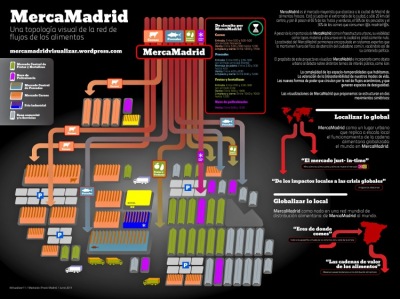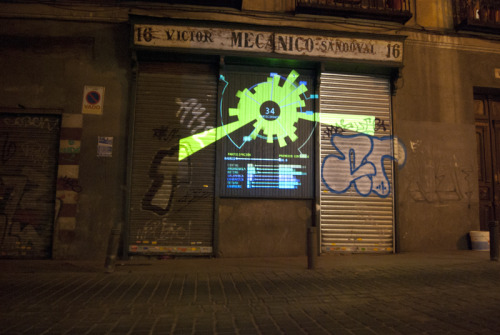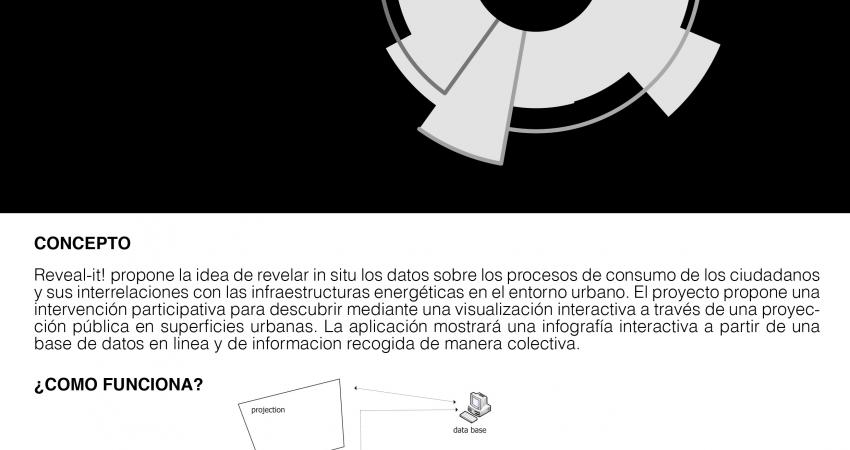Project Showcase. Visualizar'11: Understanding Infrastructures

MercaMadrid: A Visual Topology of the Network of Food Flows

By César García Sáez and Montserrat Cañedo (Madrid). Collaborators: Sara Alvarellos, Gorka Cortazar, Victor Díaz, Javier Esquillor, Beatriz García, Ester Gisbert, Martina Minnucci, Maria Olmeda, Carlos Panero, David Rodriguez and Fabio Silli.
MercaMadrid's importance as an urban infrastructure contrasts with its slight visibility as a physical and discursive location in the city. Because its activity remains confined to specialized systems, MercaMadrid doehttp://wiki.medialab-prado.es/index.php/Experiments_in_Infrastructural_… not catch the attention of average citizens, which explains the absence of political content. This project aims to envisage MercaMadrid and to establish it as an urban focal point where topics of public interest are discussed.
http://mercamadridvisualizar.wordpress.com/
more information: http://wiki.medialab-prado.es/index.php/MercaMadrid:_Una_topolog%C3%ADa_visual_de_la_red_de_flujos_de_los_alimentos
The Visual Atlas of Innovation in Spain

By Alberto Gonzalez Paje (Madrid) and Rocío Márquez (Barcelona). Collaborators: Jaime de Miguel.
This project focuses on the interactive representation of technologically based companies involved in European Framework R&D Program Projects in Spain that focus on geographical and sectorial matters. We maintain a global vision of innovative infrastructures, and strive to discover behavioral patterns as well as variable innovative results such as Gross Domestic Product (GDP) or industrial production charts. The project consists of an online processing tool and an experimental prototype of a tactile table that allows users to interact with the research results.
http://www.atlasvisualdeinnovacion.com/
more information: http://wiki.medialab-prado.es/index.php/The_Visual_Atlas_of_Innovation_in_SpainMapping Google's Infrastructure

By Marcell Mars (Croatia)
What is the political, ethical, and professional trustworthiness of Google, Facebook, Amazon and Ebay? For example, the project displays Google´s technical infrastructure (its guts) and how Google categorizes the information and services offered to users.
http://bljak.org/~marcell/dtreejs/dependency-tree2.html
more information: http://wiki.medialab-prado.es/index.php/Ruling_Class_Studies
From Extraction to Reaction

By Christopher Pandolfi (Canadá). Collaborators: Carolina Carlini, Bland Mahdi, Lorenzo Mazza, Juan Morales, Tom Schofield and Tatjana Vukelic.
The objective is to create an application that allows users to visualize the traffic of companies active in the Spanish Market index (IBEX 35) in relation to what is published in the news and Twitter (directly or indirectly associated to a specific company).
The relation between time movement and information aims to invite the viewer to question and think about the elements that shape our lives.
more information: http://wiki.medialab-prado.es/index.php/From_Extraction_to_ReactionReveal-it!

By Nina Valkanova (Bulgaria), Juan Pablo Carrascal (Colombia) and Penélope Maldonado (México). Collaborators: Javier Lloret, Víctor Díaz, Max Kazemzadeh, Erika Takenouchi.
Reveal-it! Aims to provide, on site, data on citizens’s consumer behavior and their interaction with energetic infrastructures in the urban sphere. The project proposes participatory methods of discovery by means of interactive visualizations through public projections on urban surfaces. The application shows an interactive computer graphic from an online collectively gathered database.
more information: http://wiki.medialab-prado.es/index.php/Reveal-it!
Refarm App. A new landscape to grow friends and food

By Tian Li (China) and Hernani Dias (Portugal/Barcelona). Collaborators: Miguel Alonso, Ana Ceruti, Adolfo Estalella, Erica Tekenouchi, Diego Paonessa, Rémy Greinhofer, Max Kazemzadeh, Daniela Brill, Izabel Goudart and Enrique César.
Today, being “green” is a nightmare. There are many advertisements on ecological, biological, sustainable and recycled products. But none of these are really saving anything or providing us with information on their environmental impact. Both mobile applications can help produce food and make “sustainable” decisions from the consumer's point of view.
http://www.refarmthecity.org/blog/
more information: http://wiki.medialab-prado.es/index.php/I%27m_hungry!!_what_to_do_next%3F
Where are we going?
By Beatriz Rivela (Galicia) and Irene Cuerda (Madrid). Collaborators: Lilian Döring, Sergio Galán, Christian Diaz and Martín Nadal.
Where are we going? Starting with a presentation based on real data on the degradation effects in the cycle of life, this project aims to generate thoughts on the negative impacts of the consumer culture on human activity, natural ecosystems and non-renewable resources. Transport, something close and common to everyone, is the object of study in this visualization. Mobility speaks about freedom and speed. Liberty implies the capacity to make choices and take responsibilities because in order to act freely, it is necessary to be informed. For this reason, a debate on the consequences of our own movements needs to be opened as this is where diverse agents such as the air we breathe, the ground we stand on or the tin in our blood come into play.
more information: http://wiki.medialab-prado.es/index.php/De_d%C3%B3nde_vienen_y_a_d%C3%B3nde_voy
Ontography for the Spanish Revolution: Visualizing the Metaphysics of Infrastructure

By John Calvelli Calvelli (Canadá). Collaborators: Ricardo Alvira, Massimo Avvisati, Aberto Corsin Gimenez, Gabriel Lucas, Sara Malinarich, Raquel Martine and Marijo Ribas.
Ontography seeks to make unsustainable ways of living worldwide comprehensible through images. We do not aim to imagine or create a concrete future, but rather we only want to call attention to the ethical practices necessary to create and attend to future conditions. Image as creator of the future. In other words, our social, economical and aesthetic practices should serve to satisfy basic demands without compromising our future conditions.
www.15m-ontography.terminal-5.org
more information: http://wiki.medialab-prado.es/index.php/Experiments_in_Infrastructural_Ontography
PWRT (The Psychoeconomy War Room Table)

By Gustavo Romano (Argentina). Collaborators: Chema Diez del Corral and Álvaro Jesús Osuna Martín.
PWRT starts from the metaphor of the War Room tables, the rooms where information is presented and possible tactical movements of a civic or military operation are discussed. The table (multi-touch, reactivision and fiduciary) allows the visualization of the relation between two or more countries in relation to determined socio-economical variables. The data used is obtained from the World Bank, IMF, CIA and United Nations websites.
more information: http://wiki.medialab-prado.es/index.php/PWRT_%28The_Psychoeconomy_War_Room_Table%29
Dromoart

By Arquitectura Expandida (Ana López Ortego) and Microgramma (Elisa Mandiola). Collaborators: Gastón Gontero, Evangelos Kapros and Cristina de Miguel.
Dromoart is an artistic research project that aims to reveal the infrastructure of the arts by visualizing the roaming of temporary exhibitions and its associated value as well as emphasizing in the public sphere.Through an online platform, we aim to offer comprehensible information that can bring conclusions on management mechanisms, cultural politics and institutional relations in visual arts, as well as access to information on this sector.
more information. http://wiki.medialab-prado.es/index.php/Dromoart



 Medialab-Matadero Madrid
Medialab-Matadero Madrid
